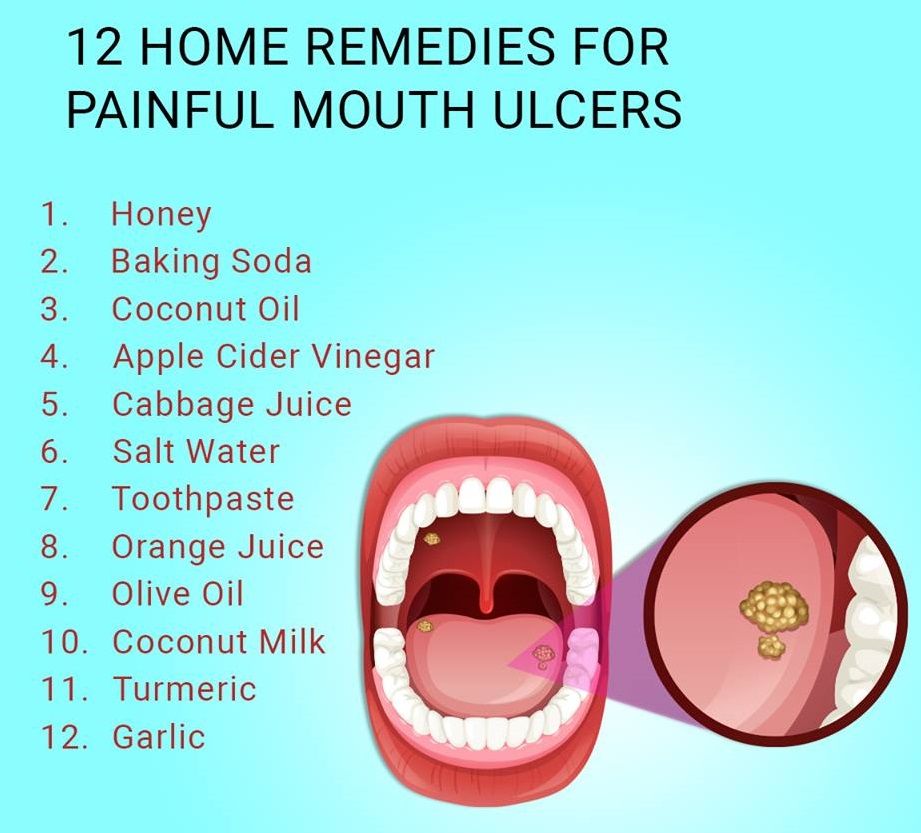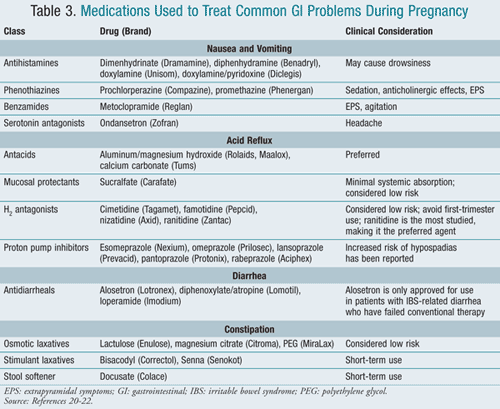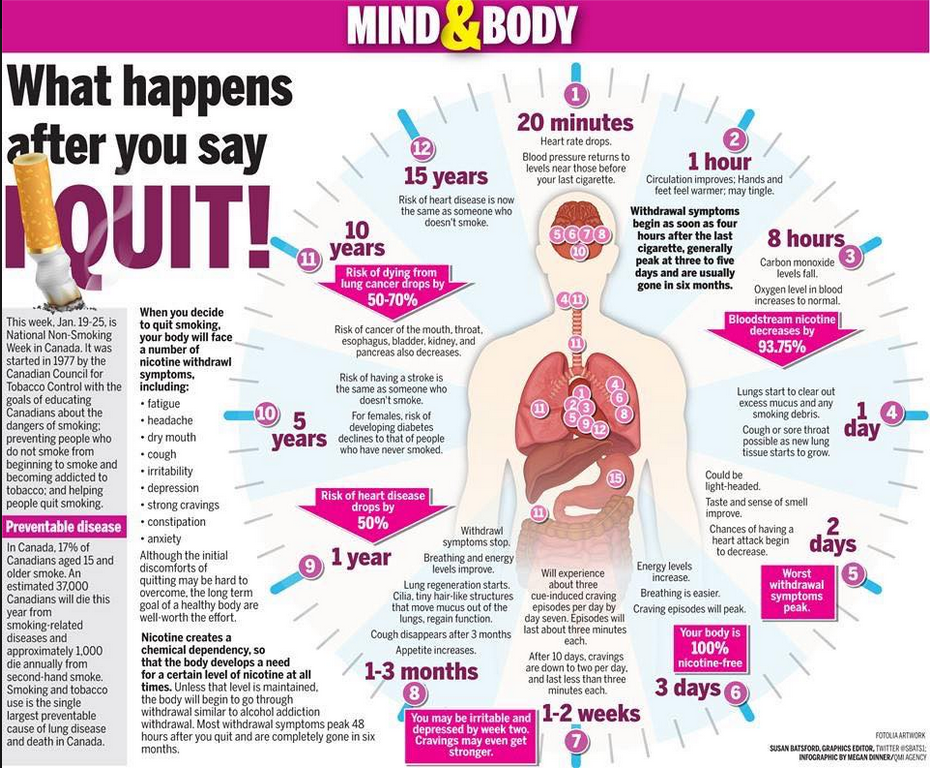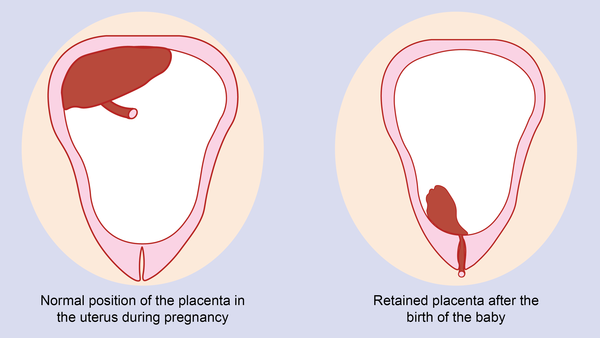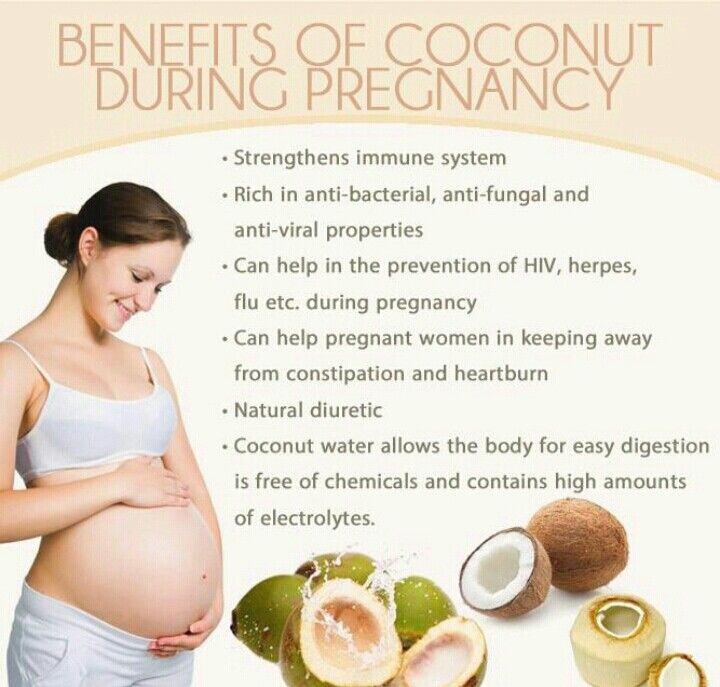Is oral thrush in babies painful
Thrush in Babies' Mouth: Symptoms and Treatment
If your baby seems cranky or uncomfortable when feeding, take a look in her mouth. White patches on the tongue, or anywhere else in the mouth or throat, could mean that a common fungal infection called oral thrush has taken hold.
But what exactly is oral thrush? Read on to learn more about thrush and what might cause it in your baby, how to spot the symptoms, how to treat or prevent this kind of infection, and how oral thrush might affect you if you’re breastfeeding.
What Is Thrush?
Thrush is a fungal infection of the mouth that can affect anyone at any age, but it's especially common in small babies, especially those younger than 6 months.
The fungus that causes thrush is a kind of yeast called candida that can live anywhere on the body, even in the mouth and digestive tract.
There's a good chance that your baby has already come into contact with candida. For example, it can be transferred in saliva through hand-to-mouth contact, or your baby might have picked it up while in the birth canal if he was born vaginally.
When the fungus grows out of control in your baby's mouth, it can develop into oral thrush, which can cause sore patches in or around your little one's mouth. These may be uncomfortable or painful, especially when feeding.
Thrush may also be transferred from your baby's mouth to your nipples if you breastfeed, which can cause you discomfort or pain, particularly when you're nursing your baby.
What Causes Oral Thrush in Your Baby?
Most of the time, the presence of candida isn’t a problem, as it’s kept in check by your baby’s immune system and “good bacteria.” But if your baby is still quite young, especially before 6 months of age, his immune system isn’t fully developed yet. This “weaker” immune system can result in an overgrowth of candida, causing oral thrush in your baby.
If your baby is being given antibiotics for an infection, this might also increase the risk of thrush because antibiotics — which are great at fighting bacterial infections — can also kill off some of those “good bacteria” at the same time. This means your baby’s natural defenses against the candida are down, and the fungus can grow out of hand.
Signs and Symptoms of Oral Thrush in Your Baby
If you suspect your baby has oral thrush, it's important to see your healthcare provider to get a diagnosis and treatment. Here are some signs and symptoms to watch out for:
Difficulties with feeding. One of the first signs you notice could be that your baby isn't feeding as well as usual, or he seems to be finding it uncomfortable or painful.
White patches. These spots may look a little like cottage cheese, and can appear on your baby's tongue, lips, gums, or the roof of his mouth. Try wiping them gently away — if they can't be removed in this way, your little one might have oral thrush.
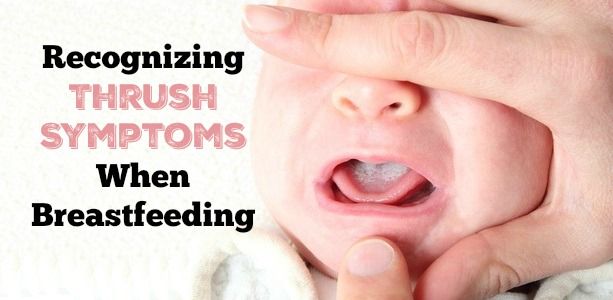 Because these patches aren't always obvious from the outside, it's a good idea to check in your little one's mouth from time to time.
Because these patches aren't always obvious from the outside, it's a good idea to check in your little one's mouth from time to time.Cracked skin at the corners of the mouth. This is another possible symptom of oral thrush in your baby.
Diaper rash. As the fungus is swallowed and passed out of your little one's system, it can cause diaper rash around your baby's bottom.
Telltale signs on your own body. If you're breastfeeding and have itchy, cracked, or sore nipples, or intense shooting pains in the nipples or breasts, these symptoms could indicate that you have thrush. Thrush can be passed between your nipples and your baby's mouth during breastfeeding. We cover how thrush can affect breastfeeding later on.
How to Treat Oral Thrush in Your Baby
If you notice any possible symptoms of thrush in your baby or yourself, check in with your healthcare provider to get a diagnosis.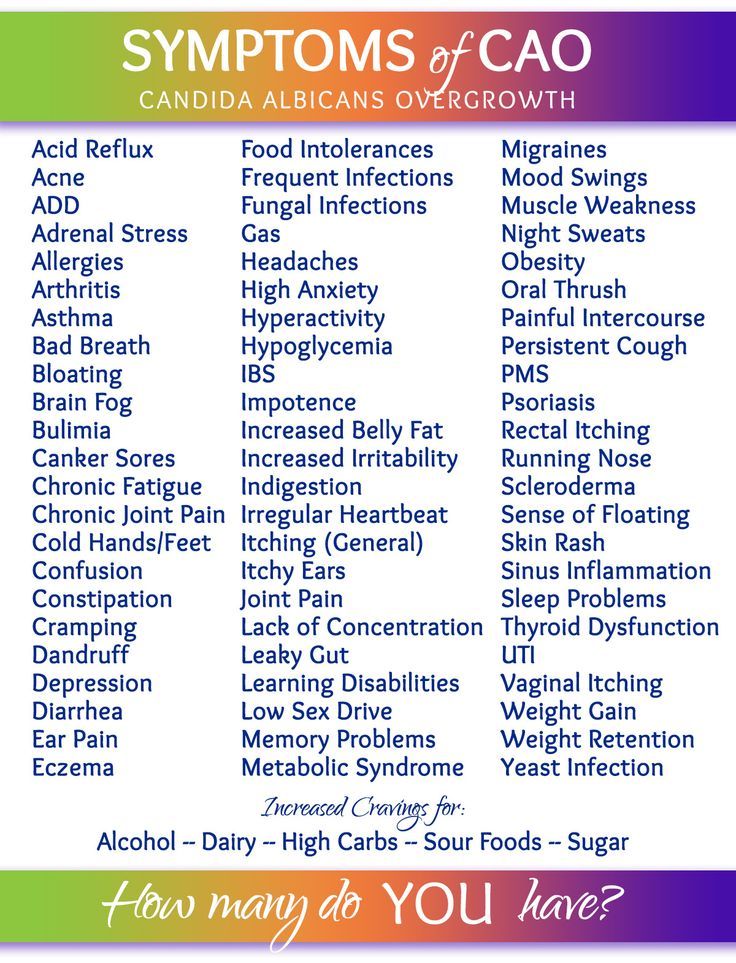 Your provider can explain your treatment options.
Your provider can explain your treatment options.
Thrush occasionally goes away by itself in a few weeks, but your healthcare provider may prescribe an antifungal treatment.
Over-the-Counter and Home Remedies for Thrush
Various over-the-counter treatments are available for thrush in your baby, but always check with your provider before using any of these.
Some moms believe that home remedies like rinsing nipples in a solution of vinegar and water or baking soda and water solution can help, as can cutting down on the amount of sugar, yeast, and dairy products in your diet.
These measures aren't medically proven to work, and should only be used alongside any medication that's prescribed by your healthcare provider, and not as a substitute for it. Always check with your provider before using any home remedies or over-the-counter medicines.
If the thrush doesn't clear up in a few weeks with treatment, or if it keeps coming back — especially if your little one is over 9 months old — see your healthcare provider to investigate whether any other health issues are at play.
How to Prevent Oral Thrush in Your Baby
These are some of the steps you can take to help prevent your little one from developing oral thrush:
Wash your baby's hands frequently, especially if your little one sucks her thumb or fingers. Wash your own hands often, too.
Regularly sterilize pacifiers, teething rings, the nipples of feeding bottles, and anything else that goes in your baby's mouth.
Put any towels or clothing that may have been in contact with the yeast through a hot wash cycle (at least 122 degrees Fahrenheit).
If you use a breast pump, make sure all the parts that come into contact with your breasts or breast milk are sterilized after every use.
Store breast milk refrigerated until just before use to prevent the growth of yeast.
You may need to throw away any expressed breast milk that you have in storage, if there's a chance that it's been contaminated with the yeast.

Keep your breasts dry and free of potential sources of yeast by changing any disposable nursing pads frequently and wearing a clean bra every day.
Preventing Reinfection
Oral thrush in babies can be hard to get rid of, especially if you're breastfeeding, partly because it is so contagious. It can spread from you to your little one and back again via your nipples, and even to and from other members of the family if you share bedding, cups, or utensils.
This is why it's essential to ensure that both you and your baby (and anyone else who has it in your household) are treated at the same time.
It also helps to take all the preventive measures you can while treating an existing case of thrush.
How Thrush Can Affect You if You’re Breastfeeding
If you're breastfeeding your baby, thrush can be a real pain — often literally — for you, as well as for your baby.
It's important to get prompt treatment, so head to your healthcare provider for diagnosis and treatment as soon as you can. Keep in mind that the symptoms may not clear up straight away.
Keep in mind that the symptoms may not clear up straight away.
In the meantime, experts advise that you keep on breastfeeding. Here are some ways you might be able to ease the discomfort and keep that breast milk flowing:
Try offering shorter, but more frequent feeds. Start with the least painful breast every time.
Rinse your nipples with clean water after every feed, and air-dry them before they go back in your bra.
If cracked nipples are making it too painful to breastfeed directly, consider expressing milk and offering it to your baby in a small cup.
An over-the-counter pain medication might help ease the pain a little. Ask your healthcare provider what's safe to take while you're breastfeeding.
Why It Might Not Be Thrush
Not all breast pain or nipple soreness is caused by thrush. If you experience sharp pains in your breast during or after feeds, and severe pains in the nipple, try changing your baby's breastfeeding position or getting her to latch on again.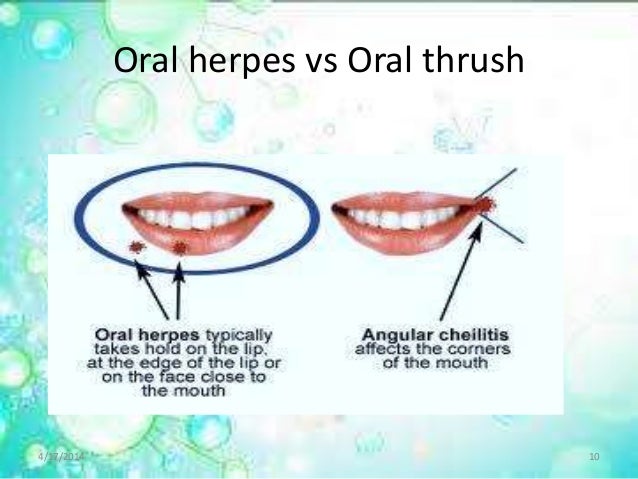 This might be all that's needed to help alleviate the pain you're feeling.
This might be all that's needed to help alleviate the pain you're feeling.
If cold compresses or air-drying make your nipple or breast pain worse, the pains could be caused by a contraction of the blood vessels in and around your nipples.
Another cause of breast pain can be a bacterial infection called mastitis.
These conditions are commonly confused with thrush, so reach out to your healthcare provider, who will be able to find the underlying cause of your discomfort.
Having a new baby can be unpredictable sometimes. One minute you’re basking in that first toothless smile, the next you’re trying to wipe away a white patch from the inside of your little one’s mouth.
Oral thrush can be one of those challenges that parenthood throws up from time to time, but with treatment from your healthcare provider it’ll clear up in due course, and you and your baby will soon be back to enjoying peaceful bonding when nursing your little one.
In the meantime, take some time out to give yourself or your baby a little treat by turning your diapers into great gifts, coupons, and discounts. Download the Pampers Rewards app to find out how.
Download the Pampers Rewards app to find out how.
Thrush in newborns Information | Mount Sinai
Candidiasis - oral - newborn; Oral thrush - newborn; Fungal infection - mouth - newborn; Candida - oral - newborn
Thrush is a yeast infection of the tongue and mouth. This common infection can be passed between a mother and baby during breastfeeding.
Causes
Certain germs normally live in our bodies. While most germs are harmless, some can cause infection.
While most germs are harmless, some can cause infection.
Thrush occurs when too much of a yeast called Candida albicans grows in a baby's mouth. Germs called bacteria and fungi naturally grow in our bodies. Our immune system helps keep these germs in check. But babies do not have fully-formed immune systems. That makes it easier for too much yeast (a type of fungus) to grow.
Thrush often occurs when mother or baby has taken antibiotics. Antibiotics treat infections from bacteria. They can also kill "good" bacteria, and this allows yeast to grow.
The yeast thrives in warm, moist areas. The baby's mouth and the mother's nipples are perfect places for a yeast infection.
Babies can also get a yeast infection on the diaper area at the same time. The yeast gets in the baby's stool and can cause a diaper rash.
Symptoms
Symptoms of thrush in the baby include:
- White, velvety sores in the mouth and on the tongue
- Wiping the sores may cause bleeding
- Redness in the mouth
- Diaper rash
- Mood changes, such as being very fussy
- Refusing to nurse because of soreness
Some babies may not feel anything at all.
Symptoms of thrush in the mother include:
- Deep-pink, cracked, and sore nipples
- Tenderness and pain during and after nursing
Exams and Tests
Your health care provider can often diagnose thrush by looking at your baby's mouth and tongue. The sores are easy to recognize.
Treatment
Your baby might not need any treatment.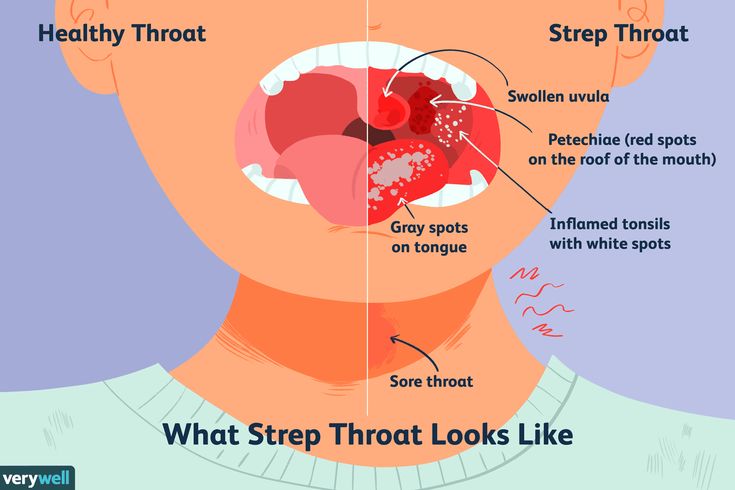 Thrush often goes away on its own in a few days.
Thrush often goes away on its own in a few days.
Your provider may prescribe antifungal medicine to treat thrush. You paint this medicine on your baby's mouth and tongue.
If you have a yeast infection on your nipples, your provider may recommend an over-the-counter or prescription antifungal cream. You put this on your nipples to treat the infection.
If both you and your baby have the infection, you both need to be treated at the same time. Otherwise, you can pass the infection back and forth.
Outlook (Prognosis)
Thrush in babies is very common and can easily be treated. Let your provider know if thrush keeps coming back. It may be a sign of another health issue.
When to Contact a Medical Professional
Contact your provider if:
- Your baby has symptoms of thrush
- Your baby refuses to eat
- You have symptoms of a yeast infection on your nipples
Prevention
You may not be able to prevent thrush, but these steps may help:
- If you bottle feed your baby, clean and sterilize all equipment, including nipples.

- Clean and sterilize pacifiers and other toys that go in baby's mouth.
- Change diapers often to help prevent yeast from causing diaper rash.
- Be sure to treat your nipples if you have a yeast infection.
Balest AL, Riley MM, O'Donnell B, Zarit JS. Neonatology. In: Zitelli BJ, McIntire SC, Nowalk AJ, Garrison J, eds. Zitelli and Davis' Atlas of Pediatric Physical Diagnosis. 8th ed. Philadelphia, PA: Elsevier; 2023:chap 2.
Harrison GJ. Approach to infections in the fetus and newborn. In: Cherry JD, Harrison GJ, Kaplan SL, Steinbach WJ, Hotez PJ, eds. Feigin and Cherry's Textbook of Pediatric Infectious Diseases. 8th ed. Philadelphia, PA: Elsevier; 2019:chap 66.
Last reviewed on: 12/12/2021
Reviewed by: Neil K. Kaneshiro, MD, MHA, Clinical Professor of Pediatrics, University of Washington School of Medicine, Seattle, WA.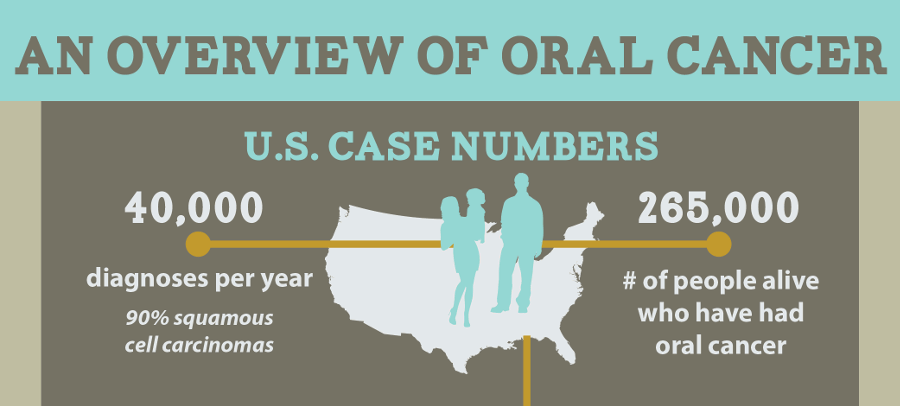 Also reviewed by David Zieve, MD, MHA, Medical Director, Brenda Conaway, Editorial Director, and the A.D.A.M. Editorial team.
Also reviewed by David Zieve, MD, MHA, Medical Director, Brenda Conaway, Editorial Director, and the A.D.A.M. Editorial team.
Candidiasis in the mouth of a child
Contents
What kind of disease is candidiasisSymptomsCausesTreatmentMethods of therapyPreventive measures
Many parents are aware of such a common problem in children as thrush, which is characterized by the appearance of white plaque on the tissues of the oral cavity. In medicine, this pathological condition has the term "candidiasis" and refers to fungal diseases.
Most often, candidiasis develops in the mouth of a child in the first year of life. Symptoms of thrush greatly disturb the baby, but timely treatment allows you to quickly and without consequences get rid of the fungus. nine0003
What kind of disease is candidiasis
According to statistics, about 30% of infants are faced with candidiasis. The causative agent of the disease is the Candida fungus.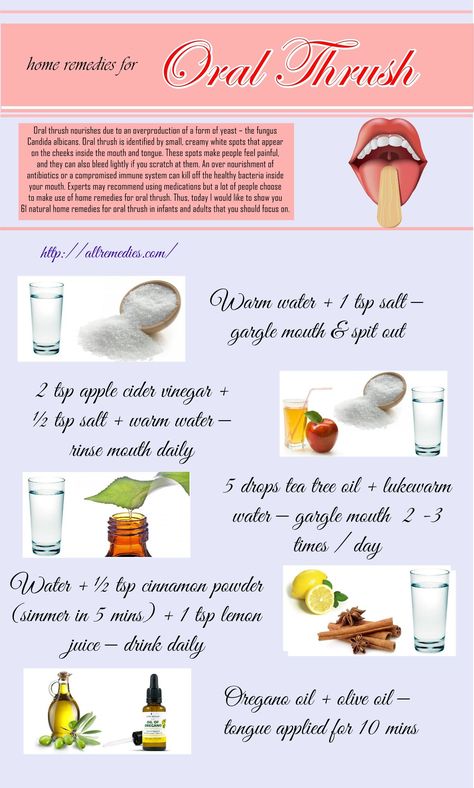 These specific microorganisms are normally present in the body of every person, even in the absence of health problems, but only in small quantities.
These specific microorganisms are normally present in the body of every person, even in the absence of health problems, but only in small quantities.
Oral candidiasis in children is much more common, since the immune system of babies is not yet formed and is not able to withstand pathogenic microorganisms and the effects of negative external factors. nine0003
With a weakened immune system and the concomitant effect of provoking factors, the fungus begins to actively multiply, affecting the mucous membranes. Without therapeutic treatment, candidiasis is eliminated in exceptional cases. If thrush is not treated, complications arise, and the infection itself spreads throughout the body.
Symptoms
Oral candidiasis in children can have a different form of manifestation and severity of symptoms: mild, moderate and severe. As a rule, each form corresponds to the stage of development of the disease. If therapy is not carried out in a timely manner, then the signs of a fungal infection become more intense and the number of symptoms increases.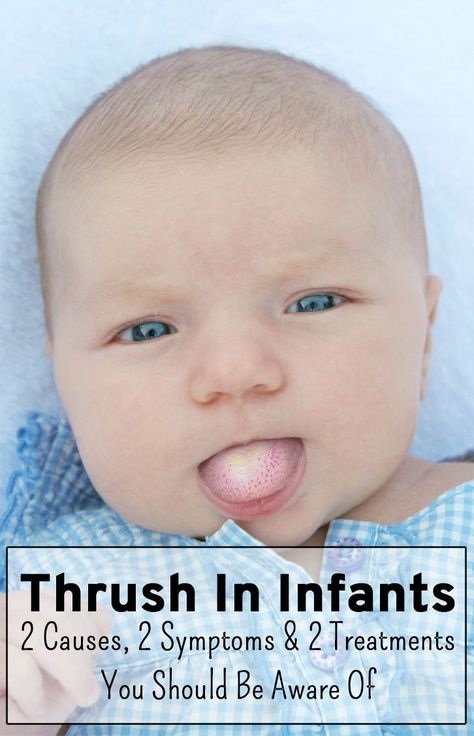 nine0003
nine0003
With a mild form of the disease, a red rash appears on the oral mucosa, which is covered with a white coating on top. At the next stage, the child has swelling of the tissues and the formation of localized white spots with a touch of curd consistency. Gradually, these spots merge into a large affected area. When plaque is removed, bleeding sores open. If the thrush starts, then the fungus already spreads to the entire oral cavity, including the lips, tongue and throat. All fabrics are completely covered with cheesy bloom. nine0003
Common symptoms of candidiasis in children include:
-
burning sensation and itching in the mouth;
-
discomfort and pain when eating;
-
frequent spitting up in babies;
-
the formation of cracks in the corners of the lips;
-
temperature rise. nine0003
Children of the first two years of life report their condition with refusal to eat, constant whims and causeless crying. It is not difficult to see signs of candidiasis, so if a child has a sharp rise in temperature or refuses to eat, pediatricians and dentists recommend checking the oral cavity for white plaque. If you suspect thrush, it is undesirable to delay a visit to a specialist, since the fungal infection progresses rapidly. nine0003
It is not difficult to see signs of candidiasis, so if a child has a sharp rise in temperature or refuses to eat, pediatricians and dentists recommend checking the oral cavity for white plaque. If you suspect thrush, it is undesirable to delay a visit to a specialist, since the fungal infection progresses rapidly. nine0003
Reasons
The main reason for the development of candidiasis of the oral mucosa in children is a weakened immune system. If a child is born prematurely, then the likelihood of having thrush is very high. Children who are breastfed or have congenital pathologies are also often exposed to fungal infection.
Provoking factors include:
-
the presence of vaginal candidiasis in the mother during pregnancy - the child can become infected when passing through the birth canal; nine0003
-
insufficient hygiene of the female breast during breastfeeding - the fungus is often localized precisely on the nipples because of the favorable environment for it;
-
poor processing of the child's initial things - bottles, nipples, and so on;
-
the habit of parents to lick the nipples - even if the adult does not have signs of thrush, a fungus may be present in the mouth, which will be transmitted to the child; nine0003
-
long-term use of drugs of the "antibiotics" group - drugs help to reduce one's own immunity;
-
frequent regurgitation in infants - after regurgitation, an increased acidic environment, favorable for the fungus, remains inside the oral cavity;
-
excessive and frequent dry mouth - the absence of saliva, as a protective agent against the activity of pathological microorganisms.
 nine0003
nine0003
Infection with Candida fungus in children older than 2 years can occur as a result of unwashed foods, raw milk or running water. If a child over 3 years of age has suddenly developed signs of thrush, one should be examined not only for a fungal infection, but also for other possible diseases that may be accompanied by a “fading” of the immune system.
Treatment
Children's fungal diseases can be dealt with by a pediatrician, infectious disease specialist or dermatologist. If we are talking about the treatment of thrush of the oral cavity, then the dentist can also carry out therapy. nine0003
The diagnosis of "candidiasis" is determined in most cases on the basis of a specialist examination of the oral cavity. If there is any doubt, the doctor directs the patient for additional examinations. To confirm the disease, a laboratory method is used to study a smear taken from the mouth for the presence of a fungus.
Treatment of thrush in children involves an integrated approach. If the disease is not advanced, then local therapy is carried out in combination with the adoption of measures to strengthen the immune system. In severe form, oral candidiasis in children is treated with systemic drugs, local remedies and compliance with preventive recommendations. nine0003
If the disease is not advanced, then local therapy is carried out in combination with the adoption of measures to strengthen the immune system. In severe form, oral candidiasis in children is treated with systemic drugs, local remedies and compliance with preventive recommendations. nine0003
Methods of therapy
Treatment of candidiasis begins with the treatment of the oral cavity. The first procedure is already performed at the reception. Antiseptic agents are used to remove plaque. The doctor may then apply an antifungal agent.
The parent should carefully monitor the actions of the dentist, as in the future they will have to independently process the oral cavity at home. The necessary drugs will be prescribed by a specialist. Local antifungal agents are dangerous in case of overdose, especially for the child's body, so you must strictly follow the doctor's recommendations. nine0003
In advanced cases, medications are prescribed in the form of solutions, drops or tablets.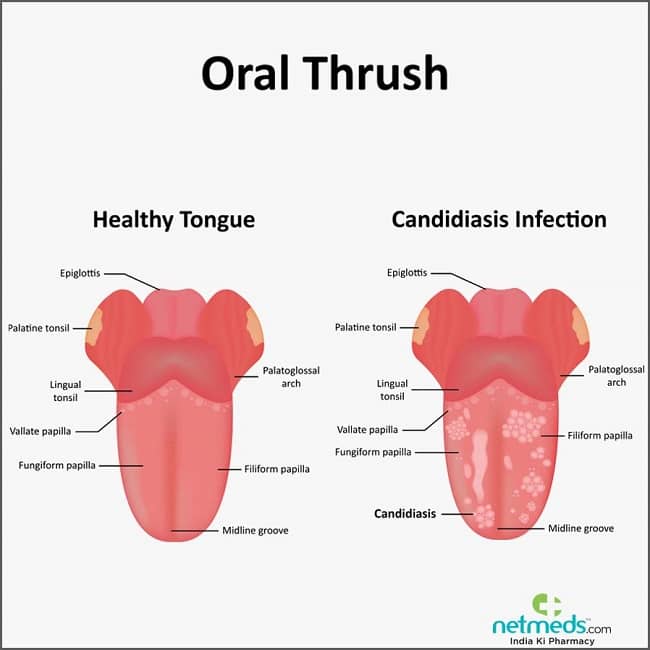 There are only a few drugs for the treatment of candidiasis in children. Replacing them with adult counterparts is dangerous. The dosage must be strictly observed.
There are only a few drugs for the treatment of candidiasis in children. Replacing them with adult counterparts is dangerous. The dosage must be strictly observed.
A mandatory addition to the main therapy is hygiene, good sleep, proper nutrition and taking measures to strengthen immunity (eating healthy foods, if necessary, pharmacy vitamins, walking. nine0003
Preventive measures
In order to prevent and even shorten the course of therapy, it is recommended to rinse the mouth (if the child is older than 3-4 years), or use antiseptic sprays several times a day.
It is not difficult to prevent oral candidiasis in children. The responsible approach of parents to the health of the child from the moment of planning conception and pregnancy will help to avoid fungal infections in babies.
Candidiasis or thrush in the mouth, symptoms and underlying causes
Oral candidiasis: what is it?
A fungus of the genus Candida can settle on the lining of the mouth, which causes a disease called candidiasis, or oral thrush.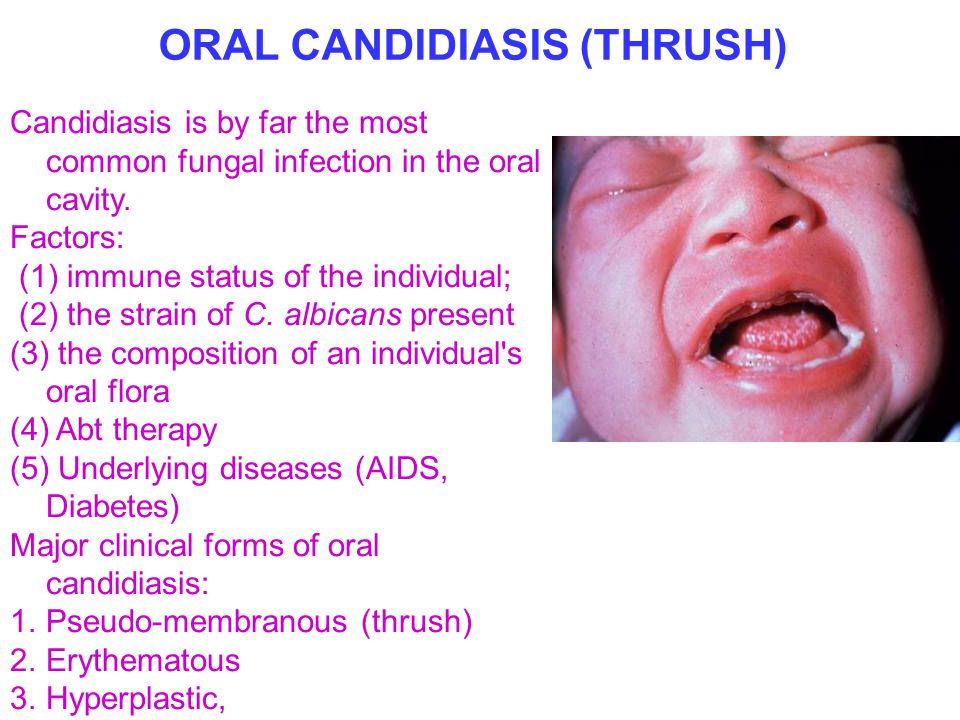 With this disease, white plaques appear on the tongue and the inner surface of the cheeks. During tongue cleaning, they can cause soreness and even slight bleeding. Without treatment, candidiasis can spread to other parts of the mouth, such as the back of the throat, tonsils, gums, and palate. nine0003
With this disease, white plaques appear on the tongue and the inner surface of the cheeks. During tongue cleaning, they can cause soreness and even slight bleeding. Without treatment, candidiasis can spread to other parts of the mouth, such as the back of the throat, tonsils, gums, and palate. nine0003
Although no one is immune from oral candidiasis, it is more common in immunocompromised people, denture wearers, patients taking inhaled corticosteroids, and infants. Oral thrush also occurs in people undergoing chemotherapy or radiotherapy, patients with a history of dry mouth syndrome (xerostomia) and smokers.
Causes of oral candidiasis
A number of well-defined factors contribute to the development of oral thrush. The causes of the disease can be both a weakening of the immune system (caused by illness or the use of certain drugs), and the use of antibiotics, which changes the natural microbial balance in the human body. nine0003
The result of failures in the natural defense mechanisms can be a significant imbalance of "beneficial" and "harmful" microbes.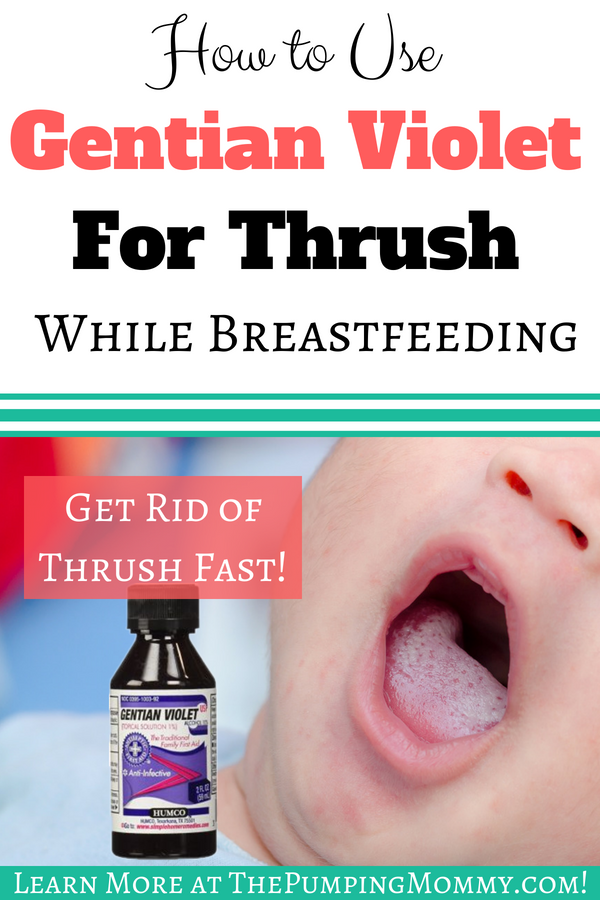 Under normal circumstances, the immune system fights viruses and bacteria that are dangerous to humans, but with a weakened immune system, this fight becomes less effective, which allows the fungus that causes oral candidiasis to multiply.
Under normal circumstances, the immune system fights viruses and bacteria that are dangerous to humans, but with a weakened immune system, this fight becomes less effective, which allows the fungus that causes oral candidiasis to multiply.
Vaginal fungal infections, diabetes, most forms of cancer, HIV/AIDS all weaken the body and make it more vulnerable to oral thrush. nine0003
Oral candidiasis in immunocompromised adults
Oral candidiasis can spread to other organs such as the lungs, liver, and digestive tract. With the penetration of infection into the intestines, a violation of its work and an even greater weakening of the body are possible.
Depending on the severity of your illness, you may be prescribed antifungal medicines that come in the form of tablets, lozenges, and a mouthwash that you swallow. Amphotericin B, which is often used in the treatment of advanced HIV and other antifungal drug-resistant infections, may also be prescribed. nine0003
Because some antifungal drugs can damage the liver, your doctor will likely do regular blood tests and monitor your liver (especially if it has already been infected).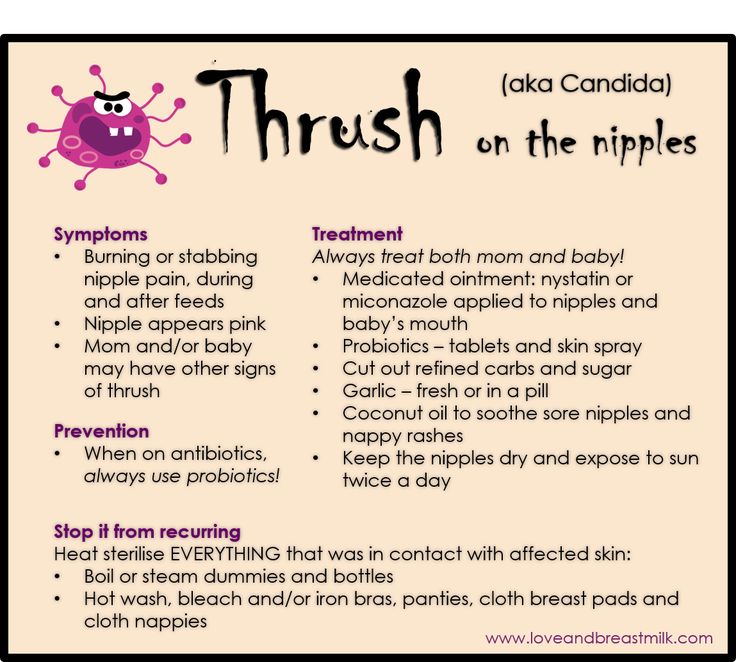 This same strategy should be used if you are on long-term treatment or if you have liver disease.
This same strategy should be used if you are on long-term treatment or if you have liver disease.
Symptoms of oral thrush in children and adults
In some cases, the symptoms of oral candidiasis may not appear immediately: sometimes they can appear completely unexpectedly. Here are some tell-tale signs that you may have oral thrush:
- White, cheesy plaques anywhere in the mouth
- Unusual pain with habitual movements of the tongue and jaw
- Bleeding of plaques when rubbed
- Cracks and redness in the corners of the lips (more often when wearing prostheses)
- Dry mouth
- Marked loss of taste in eating and drinking
Although thrush most often develops in the most visible areas of the mouth, lesions can also occur in the esophagus. This makes swallowing difficult or feels like the food is stuck in the throat. This happens in the most severe cases, and if you have any of these symptoms, you should immediately contact your dentist or GP. nine0003
nine0003
While waiting for treatment, you can relieve pain yourself if you have any. Eat unsweetened yogurt or take probiotics containing lactobacillus acidophilus. Neither is a cure in the truest sense of the word, but it can help restore normal microflora. If the infection persists, your doctor will likely prescribe you an antifungal medication or antibiotics.
Symptoms of oral candidiasis in infants and nursing mothers
With oral candidiasis, the baby may have difficulty feeding or become more restless and irritable than before. A manifestation of thrush is most likely to be white plaques in the child's mouth. Mothers should keep a close eye on their baby's oral health because candidiasis is transmitted through breastfeeding, and if this happens and the baby then recovers, the mother may inadvertently infect it again.
As a breastfeeding mother, look out for the following signs and symptoms:
- Itching, tenderness or unusual redness of the nipples
- Shiny or flaky skin around alveoli
- Unusual pain during or between feedings
- Severe, piercing pain in the chest
If white plaques appear in your mouth or in your child's mouth, contact your doctor or dentist immediately.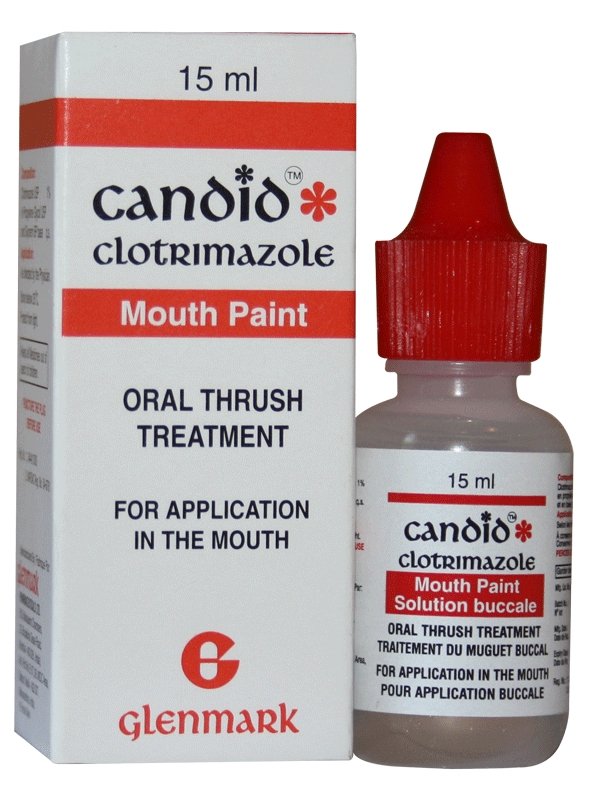 Do not postpone a visit to the doctor if symptoms of candidiasis occur in older children or adolescents, since diabetes may be the main disease against which thrush has developed. nine0003
Do not postpone a visit to the doctor if symptoms of candidiasis occur in older children or adolescents, since diabetes may be the main disease against which thrush has developed. nine0003
Since there are two people to be treated at once, the doctor may use a special strategy, such as starting with two different antifungals: a cream for your breasts and another medicine for your baby.
If you are breastfeeding, use lactation pads to prevent fungus from getting on your clothes. Do not buy liners with plastic membranes, as they only encourage fungus to thrive. Reusable liners (and, of course, the bra itself) should be washed in hot water with bleach to help keep the infection from spreading. nine0003
If you are breastfeeding your baby, but also bottle feeding, and give him a pacifier, wash all objects that come into contact with the baby's mouth daily in a solution of equal parts water and vinegar. After washing, let things air dry to prevent the growth of fungus. In the same way, you need to process all parts of the breast pump, especially its removable parts.
Physician or dentist consultation
If you suspect that you have an oral disease that requires medical attention, make a list of all the symptoms you have, including any that you may think are not related to thrush: the doctor will understand whether they are important or not. Also include non-medical events in this list, such as increased stress levels and causes of anxiety. Indicate if you are in the company of people with a weakened immune system. nine0003
You will also need to have a list of all the medicines you take. Also, write down the questions you want to ask the doctor. This will help you find out all the details you are interested in and get a comprehensive consultation, regardless of whether you have oral candidiasis or not.
Your doctor may ask you follow-up questions that will allow him to narrow down his search for a diagnosis based on the symptoms he has identified and the symptoms you describe. Try to answer as frankly and honestly as possible so that the doctor can quickly diagnose the disease and begin treatment without waiting for complications. nine0003
nine0003
If the examination of the oral cavity does not allow the doctor to make an accurate diagnosis, he will definitely take a small sample and either examine it himself or give it to the laboratory for analysis.
If the infection has already affected not only the oral cavity, but also the esophagus, a couple of studies may be required. First of all, the doctor will take a swab from the back of the throat to determine which bacteria or fungi have become (and have become) the cause of the symptoms. Then you may need to have an endoscopy, in which your doctor uses an endoscope (flexible tube with light) to look at your esophagus, stomach, and upper small intestine. This will determine how far the infection has spread. nine0003
Lifestyle and home remedies for oral thrush
At the initial stage of candidiasis, good oral hygiene will help to contain the development of the disease - brushing your teeth twice a day and at least daily flossing will help to timely remove food debris and plaque from the surface of the teeth , from interdental spaces and along the gum line.